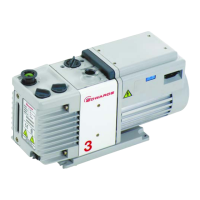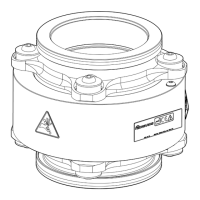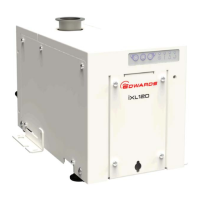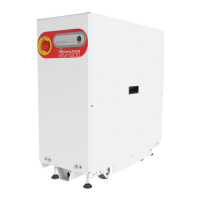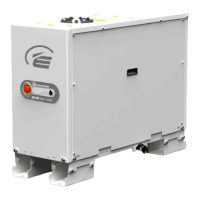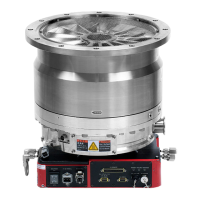© Edwards Limited 2013. All rights reserved. Page 57
Edwards and the Edwards logo are trademarks of Edwards Limited.
Maintenance
A708-01-880 Issue E
Choose a cleaning solution suitable for the process substances pumped. The quantities of cleaning solution required
to completely flood all the unblocked cavities in the pump is shown in Table 3.
1. Switch on the shaft-seals purge gas supply. If not, the lip seals in the pump will contaminate when flushing with
cleaning solution.
2. Switch off the pump, and leave it for at least 15 minutes (see warning above).
3. Refer to Figure 1, 2 and 3. Remove the four bolts which secure one of the coupling covers (20) and remove the
coupling cover.
4. If a pump inlet isolation-valve is in the system, close the valve. If a pump inlet isolation-valve is not in the
system, disconnect the pump inlet (6) from the process system and fit a blanking-flange to the pump inlet.
5. Refer to Figure 11. Remove the two plugs (1, 2) from the cleaning solution flush ports.
6. Disconnect the pump outlet (Figure 1, 2 and 3, item 16) from the exhaust pipeline and fit a blanking-flange to
the pump outlet.
7. Slowly pour a suitable cleaning solution into one of the cleaning solution flush ports (1, 2). (The other port will
allow air to vent from the pump when filling it.) Wait for several minutes to allow the cleaning solution to drain
into the pump.
8. Repeat Step 7 until the level of cleaning solution in the pump reaches the flush ports (see Ta bl e 3 for the
capacity of the pump).
9. Leave the pump for at least one hour for the cleaning solution to fully react with the deposits in the pump.
10. Fit a steel rod or other suitable tool (not supplied) into one of the 16 mm (0.625 inch) holes in the drive hub
(Figure 14, item 19), then try to turn the pump clockwise:
z If the pump cannot be turned, continue at Step 9 (to leave the pump for longer).
z If the pump can be turned, continue at Step 11.
11. Place a suitable container under the pump outlet (Figure 1, 2 and 3, item 16) and remove the blanking-flange.
12. Use the steel rod or tool to turn the pump clockwise through three or four complete revolutions. If the pump
seizes, this is probably because of a hydraulic lock in the pump: wait for a few seconds for the cleaning solution
to drain through the pump.
13. If necessary, repeat Steps 7 to 12 to flush the pump again.
14. Remove the blanking-flange from the pump inlet (Figure 1, 2 and 3, item 6) and reconnect the pump inlet to the
process system (refer to Section 3.15.1) or open the pump inlet isolation-valve.
15. Reconnect the pump outlet to the exhaust pipeline: refer to Section 3.15.2.
16. Refer to Figure 1, 2 and 3. Refit the coupling cover (20) and secure with the four bolts (removed in Step 3).
17. Tighten the bolts to a torque between 3 and 5 Nm (2.2 and 3.7 lbf ft).
18. Refit the two plugs (Figure 11, items 1 and 2) to the cleaning solution flush ports.
19. Dispose of the used cleaning solution and deposits removed.
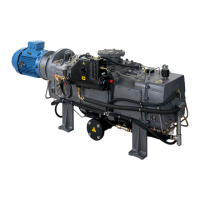
